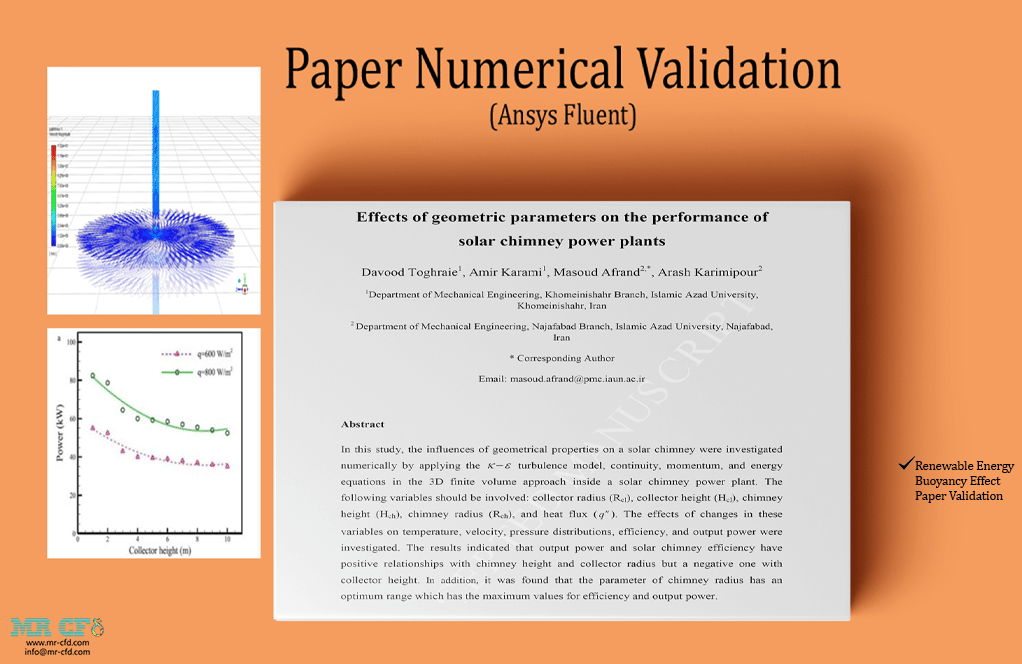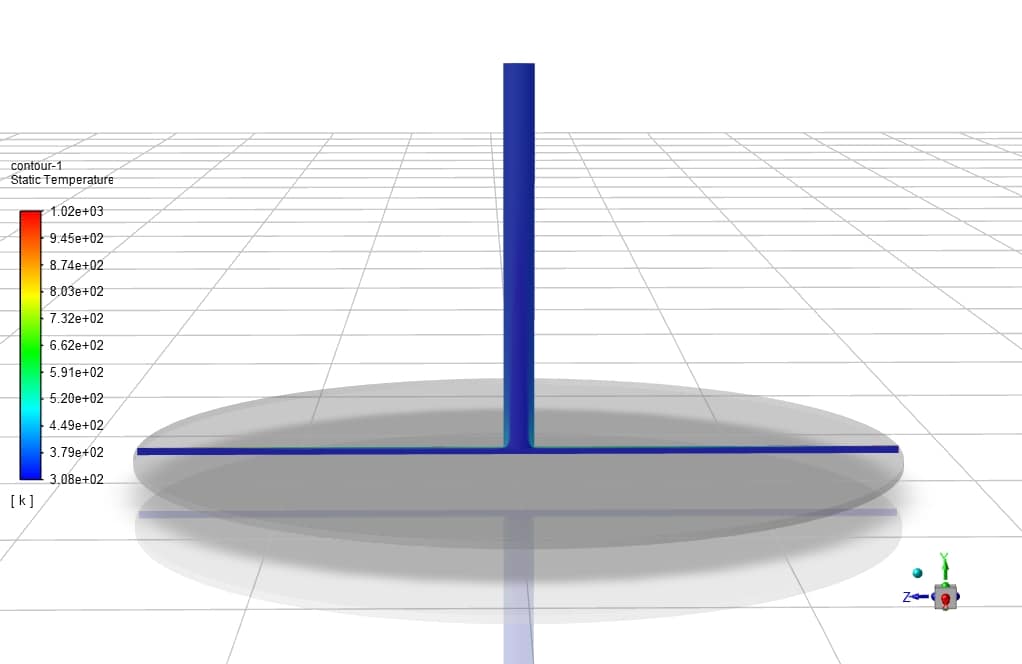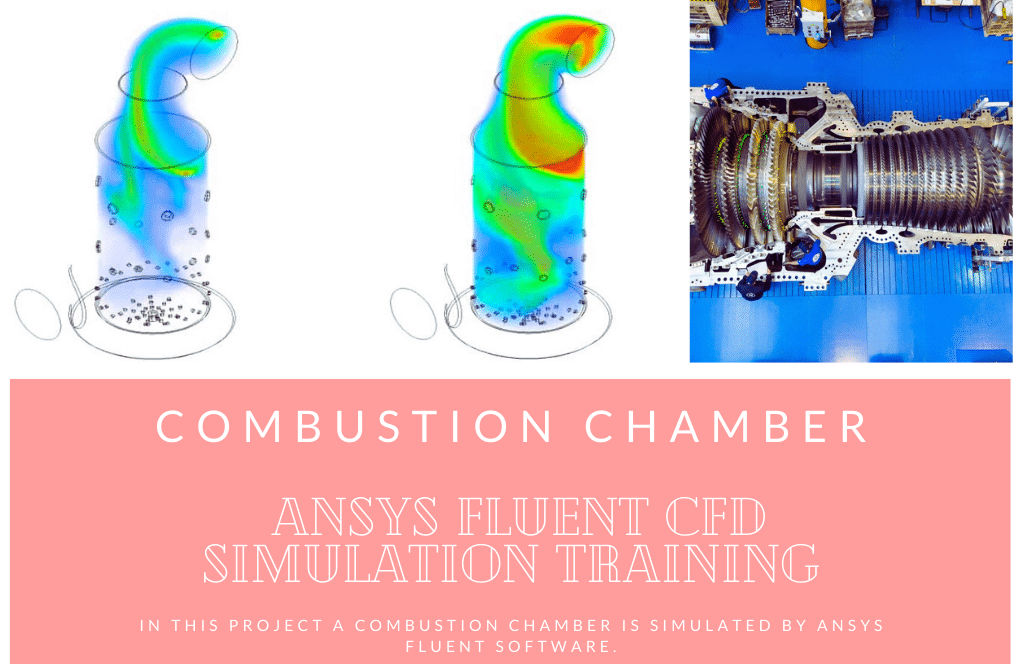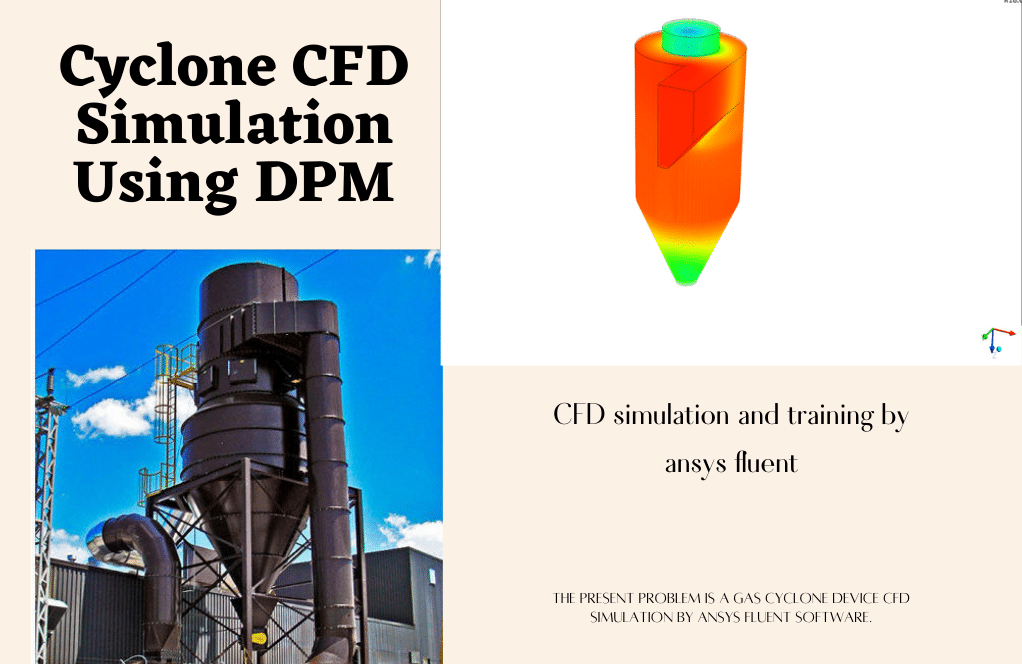Solar Chimney Power Plants, Paper CFD Validation
$180.00 $90.00 Student Discount
- The problem numerically simulates Solar Chimney Power Plants using ANSYS Fluent software.
- We design the 3-D model by the Design Modeler software.
- We mesh the model with ICEM software.
- The mesh type is Structured, and the element number equals 6000000.
- This project is simulated based on a reference Article and validated its results.
To Order Your Project or benefit from a CFD consultation, contact our experts via email (info@mr-cfd.com), online support tab, or WhatsApp at +44 7443 197273.
There are some Free Products to check our service quality.
If you want the training video in another language instead of English, ask it via info@mr-cfd.com after you buy the product.
Description
Solar Chimney Power Plants, Paper Numerical Validation, ANSYS Fluent CFD Simulation Training
In this project, we intend to simulate the solar chimney power plants to compare and validate the results in the article “Effects of geometric parameters on the performance of the solar chimney power plants” using ANSYS Fluent software. We perform this CFD project and investigate it by CFD analysis.
The present model is designed in three dimensions using SOLIDWORKS and then imported into the Design Modeler software. The solar chimney model has a duct height equal to 100m, duct diameter equal to 4m, collector height equal to 2m, and collector radius equal to 100m.
The meshing of this project has been done with ICEM software. The mesh type is Structured.
CFD Methodology
First, To check the mesh independence and eliminate the error of the number of elements, it is necessary to lower the mesh so that our results are no longer affected by the number of grid elements.
For this purpose, we start with the element number 25000, and by doubling the number of elements, we examine the output speed of the pipe as a measure of independence from the mesh.
| Element Number | Power | Error(%) | |
| 1 | 2000000 | 76051 | |
| 2 | 4000000 | 79413 | 4.233563774 |
| 3 | 6000000 | 80600 | 1.472704715 |
In this project, the airflow enters radially through a pressure inlet boundary with a temperature equal to 308K and passes below a heated wall with a heat flux of 600-800W/m2. The heated air continues to the center of the solar plant, where it can leave the domain through a chimney.
The air density is set to follow the Boussinesq law, in which the air density changes based on the temperature. Moreover, the standard k-epsilon model is used to solve turbulent fluid equations.
Chimney Conclusion
At the end of the solution process, two- and three-dimensional contours related to pressure, velocity, and temperature are obtained. For instance, by viewing the temperature contour, it is clear that the entering airflow has gained temperature by moving adjacent to the heat walls.
Also, by comparing the simulation results with the results in the article, which have an error of less than 5%, it can be concluded that the article has validated the simulation.
| Error% | Power- paper | Power-simulation | Flux |
| 1.275 | 80000 | 81020 | 800 w/m^2 |
| -2.5 | 54500 | 53100 | 600 w/m^2 |










Brianne McClure –
Fantastic resource! The detailed validation against the published article gave me confidence in the accuracy of the simulation process. It also highlighted the impact of geometric parameters on solar chimney performance.
MR CFD Support –
Thank you for your positive review. We appreciate your recognition of the meticulous validation work that underpins the simulation. It’s great to hear that our efforts to ensure accuracy and provide valuable insights on solar chimney power plants have been beneficial to you.
Larry Schulist –
I really appreciated how the project aimed to validate the results against a known article, ensuring credible outcomes. The detailed approach to assessing mesh independence and establishing an accurate simulation was insightful.
MR CFD Support –
Thank you for your positive feedback! We’re pleased to know that our efforts to ensure accurate validation and detailed mesh independence have been well received. We aim to provide high-quality simulations and are glad that you found our methodologies insightful.
Grayce Littel –
The simulation results being within 5% of the article’s data is impressive; could you explain how the heat flux consistency was maintained across the model’s surface for accurate results?
MR CFD Support –
In the simulation process, uniform heat flux boundaries were carefully applied to the collector’s surface to ensure that the heat flux remained consistent throughout the simulation. This was essential to accurately mimic the heat transfer dynamics present in solar chimney power plants and to guarantee the validity of the comparison with the article’s data.
Schuyler Kilback –
The CFD analysis of solar chimney simulation was insightful! It’s impressive how the validation shows an error of less than 5%. Really shows the reliability of the simulation process.
MR CFD Support –
Thank you for your kind words! We’re glad to know that our CFD simulation and validation against the academic paper met your expectations and provided reliable results. Accuracy is crucial for us, and we aim to ensure our simulations are as close to real-life scenarios as possible.
Charles Li –
Interesting work! I’m curious about the inlet / outlet velocity boundary condition. Can you let us know the setup?
Damian Schaefer PhD –
Your product helped deepen my understanding of how changing geometric parameters can affect the efficiency of solar chimney power plants. I just wanted to say thanks!
MR CFD Support –
Thank you for your positive feedback! We’re thrilled to hear that our CFD simulation training enhanced your understanding of solar chimney power plants efficiency. If there’s anything more we can help you with, please let us know.
Dr. Weldon Kub III –
Absolutely fantastic resource! The detailed comparison with the paper’s results instills a lot of confidence in the simulation’s accuracy. Well done on maintaining under 5% error!
MR CFD Support –
Thank you so much for your positive review! We’re thrilled to hear that our product met your standards for accuracy, and we’re glad the detailed validation was helpful for you.
Khalil Fritsch –
The simulation results are absolutely remarkable! It’s incredible how the process mirrors the actual performance indicators in the source article with such high accuracy.
MR CFD Support –
Thank you for your positive feedback! It is our goal to provide detailed and accurate simulations that closely replicate real-world scenarios. We’re thrilled to hear that you’re impressed with the results and the fidelity of our simulation’s validation process.
Axel Schamberger –
I appreciate the detailed explanation of the methodology and thorough validation with the research paper. It provides confidence in the simulation’s accuracy.
MR CFD Support –
Thank you for your positive feedback! We’re glad to hear that our documentation met your expectations and provided a clear and accurate comparison for validation purposes. We continually strive to ensure our simulations are both comprehensive and reliable.
Hillary Lakin Sr. –
The training content and the process of validation against the paper were extremely informative. MR CFD’s approach made it easy to understand the impact of geometric parameters on solar chimney power plant performance.
MR CFD Support –
Thank you very much for your positive feedback! We are thrilled to hear that our CFD training for solar chimney power plants has been helpful and informative. It’s great to see our efforts in conveying complex concepts in an understandable way are appreciated. If you have any further questions or need more learning materials, feel free to reach out!
Marisol Reinger –
The structured meshing in ICEM seems quite optimal. I noticed an increase in temperature as the air passes near the heated walls, but how does the model deal with turbulence near those walls?
MR CFD Support –
The standard k-epsilon turbulence model is employed to capture the complexities of airflow, including turbulence, as the air passes near the heated walls. Such a model allows for the prediction of both the average flow properties and the turbulent fluctuations. Consequently, this provides a more accurate representation of the behavior of heated air as it encounters the walls and rises within the solar chimney, contributing to its efficiency.
Maxine Carter DDS –
This is genuinely impressive work in simulating solar chimney power plants, and it’s great to see the close match up with the referenced paper’s results. Less than 5% error is quite remarkable for a CFD simulation. It demonstrates the high quality of the work and the attention to detail in setting up the problem. This is exactly the kind of reliability and accuracy I was hoping for when I chose to depend on MR CFD’s learning materials and services!
MR CFD Support –
Thank you for your very positive review. It’s rewarding to hear that our simulation training met your expectations in terms of accuracy and reliability. We always strive for precision and relevance in our training materials, and feeling confident about matching research convincingly is our aim. We appreciate your feedback and are glad that our product has contributed to your learning experience.
Tristin Pacocha –
Is there any particular reason for choosing the structured mesh and this specific range of mesh sizes for the solar chimney validation study?
MR CFD Support –
The structured mesh was chosen due to its ability to capture the detailed flow patterns through the system while being computationally efficient. For mesh size, we begin with a coarse mesh to establish a baseline, and progressively refine it to ensure mesh independence. The specific range you see was selected to strike a balance between accuracy (ensuring numerical predictions are not influenced by mesh size) and computational cost.